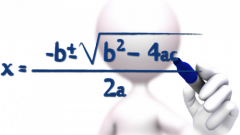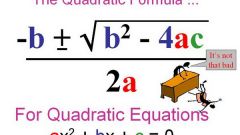Instruction
1
Unlike other types of equations, for example, square or systems of linear equations to solving equations with roots, or rather, irrational equations, there is no standard algorithm. In each case it is necessary to choose the most appropriate method of solutions based on "appearance" and the characteristics of the equation.
The construction of the equation in the same degree.
Most often for the solution of the equations with roots (irrational equations) is used in the construction of both parts of the equation to the same degree. As a rule, in degree equal to the degree of the root (square root, square, cube root cubic). It should be borne in mind that during the construction of the left and right side of the equation of even degree may have "extra" roots. Therefore, in this case, you should check the roots by substituting them into the equation. Special attention in the solution of equations with a square (even) roots should be paid to the region of the allowed values of the variable (DHS). Sometimes only one assessment DHS sufficient for the solution or substantial "simplification" of the equation.
Example. Solve the equation:
√(5x-16)=x-2
Erected both sides of this equation in a square:
(√(5x-16))2=(x-2)2, where consistently get:
5x-16=x2-4x+4
x2-4x+4-5x+16=0
x2-9x+20=0
Solving the obtained quadratic equation, find its roots:
x=(9±√(81-4*1*20))/(2*1)
x=(9±1)/2
x1=4, x2=5
Substituting both of the found root in the original equation, we get true equality. Therefore both numbers are solutions of the equation.
The construction of the equation in the same degree.
Most often for the solution of the equations with roots (irrational equations) is used in the construction of both parts of the equation to the same degree. As a rule, in degree equal to the degree of the root (square root, square, cube root cubic). It should be borne in mind that during the construction of the left and right side of the equation of even degree may have "extra" roots. Therefore, in this case, you should check the roots by substituting them into the equation. Special attention in the solution of equations with a square (even) roots should be paid to the region of the allowed values of the variable (DHS). Sometimes only one assessment DHS sufficient for the solution or substantial "simplification" of the equation.
Example. Solve the equation:
√(5x-16)=x-2
Erected both sides of this equation in a square:
(√(5x-16))2=(x-2)2, where consistently get:
5x-16=x2-4x+4
x2-4x+4-5x+16=0
x2-9x+20=0
Solving the obtained quadratic equation, find its roots:
x=(9±√(81-4*1*20))/(2*1)
x=(9±1)/2
x1=4, x2=5
Substituting both of the found root in the original equation, we get true equality. Therefore both numbers are solutions of the equation.
2
A method of introducing a new variable.
Sometimes to find the roots of the equation with roots (irrational equations) the method of introducing new variables. In fact, the essence of this method is simply to more compact recording solution, i.e., instead of each time to write the cumbersome expression, it is replaced with symbol.
Example. Solve the equation: 2x+√x-3=0
You can solve this equation and the construction of both parts in the square. However, calculations in this case will look quite cumbersome. With the introduction of a new variable, the solution process will succeed much more elegant:
We introduce a new variable: y=√x
Then get an ordinary quadratic equation:
2у2+y-3=0, with y variable.
Solving obtained equation, we find two roots:
U1=1 and U2=-3/2,
substituting the found roots in the expression for the new variable (y), we get:
√x=1 or √x=-3/2.
Since the value of the square root cannot be a negative number (if not to touch the area of complex numbers), then we obtain the only solution:
x=1.
Sometimes to find the roots of the equation with roots (irrational equations) the method of introducing new variables. In fact, the essence of this method is simply to more compact recording solution, i.e., instead of each time to write the cumbersome expression, it is replaced with symbol.
Example. Solve the equation: 2x+√x-3=0
You can solve this equation and the construction of both parts in the square. However, calculations in this case will look quite cumbersome. With the introduction of a new variable, the solution process will succeed much more elegant:
We introduce a new variable: y=√x
Then get an ordinary quadratic equation:
2у2+y-3=0, with y variable.
Solving obtained equation, we find two roots:
U1=1 and U2=-3/2,
substituting the found roots in the expression for the new variable (y), we get:
√x=1 or √x=-3/2.
Since the value of the square root cannot be a negative number (if not to touch the area of complex numbers), then we obtain the only solution:
x=1.






